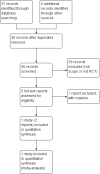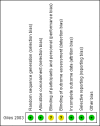Regimens of ultrasound surveillance for twin pregnancies for improving outcomes
- PMID: 29108135
- PMCID: PMC6486298
- DOI: 10.1002/14651858.CD011371.pub2
Regimens of ultrasound surveillance for twin pregnancies for improving outcomes
Abstract
Background: Increased ultrasound surveillance of twin pregnancies has become accepted practice due to the higher risk of complications. There is no current consensus however as to the method and frequency of ultrasound monitoring that constitutes optimal care.
Objectives: To systematically review the effects of different types and frequency of ultrasound surveillance for women with a twin pregnancy on neonatal, fetal and maternal outcomes.
Search methods: We searched Cochrane Pregnancy and Childbirth's Trials Register, ClinicalTrials.gov, the WHO International Clinical Trials Registry Platform (ICTRP) (all searched 11 August 2017), and reference lists of retrieved studies.
Selection criteria: Randomised and quasi-randomised trials (including those published in abstract form) comparing the effects of described antenatal ultrasound surveillance regimens in twin pregnancies. Trials using a cluster-randomised design would have been eligible for inclusion in this review but none were identified. Trials using a cross-over design are not eligible for inclusion in this review.Different types and frequencies of ultrasound testing (for fetal surveillance and detection of specific problems) compared with each other and also compared with no testing. For example, an intervention might comprise a specific approach to ultrasound examination with dedicated components to detect twin-specific pathology. Different interventions could also include a specific type of surveillance at different intervals or different combinations at the same intervals.In this review we only found one study looking at fetal growth (biometry) and Doppler ultrasounds at 25, 30 and 35 weeks' gestation versus fetal growth alone.
Data collection and analysis: Two review authors independently assessed trials for inclusion and quality, and extracted data. We checked data for accuracy.
Main results: We included one trial of 526 women with a twin pregnancy of two viable twins, with no known morphological abnormality, in this review. The trial compared women receiving fetal growth and Doppler ultrasounds at 25, 30 and 35 weeks' gestation to fetal growth alone. We judged the included study to be at low risk of bias however the risk of performance and detection bias were unclear.The primary outcome was the perinatal mortality rate (after randomisation), for which there was no evidence of a clear difference between the fetal growth + Doppler and the fetal growth alone groups (risk ratio (RR) 0.88, 95% confidence interval (CI) 0.32 to 2.41, low-quality evidence) with similar rates in both groups (seven events in the Dopper + fetal growth group and eight in the fetal growth alone group). No clear differences were seen between the two regimens for the other outcomes in this review: stillbirth (RR 0.67, 95% CI 0.11 to 3.99), neonatal death (RR 1.01, 95% CI 0.29 to 3.46, low-quality evidence), gestational age at birth (weeks) (mean difference 0.10, 95% CI -0.39 to 0.59, moderate-quality evidence), infant requiring ventilation (RR 0.86, 95% CI 0.59 to 1.25), admission to special care or intensive care units (RR 0.96, 95% CI 0.88 to 1.05), caesarean section (any) (RR 1.00, 95% CI 0.81 to 1.23, high-quality evidence), elective caesarean section (RR 1.06, 95% CI 0.77 to 1.47), emergency caesarean section (RR 0.93, 95% CI 0.66 to 1.32), induction of labour (RR 1.10, 95% CI 0.80 to 1.50, moderate-quality evidence) or antenatal hospital admission (RR 0.96, 95% CI 0.80 to 1.15, high-quality evidence). The number of preterm births before 28 weeks' gestation was not reported in the included study. For the mortality-related outcomes, event numbers were small.The included study did not report the majority of our maternal and infant secondary outcomes. Infant outcomes not reported included fetal acidosis, Apgar scores less than 7 at five minutes and preterm birth before 37 and 34 weeks' gestation. The maternal outcomes; length of antenatal hospital stay, timely diagnosis of significant complications, rate of preterm, prelabour rupture of membranes and women's level of satisfaction with their care were not reported. The study did not classify twin pregnancies according to their chorionicity. An awareness of the chorionicity may have improved applicability of this data set.We downgraded outcomes assessed using GRADE for imprecision of effect estimates.
Authors' conclusions: This review is based on one small study which was underpowered for detection of rare outcomes such as perinatal mortality, stillbirth and neonatal death.There is insufficient evidence from randomised controlled trials to inform best practice for fetal ultrasound surveillance regimens when caring for women with a twin pregnancy. More studies are needed to evaluate the effects of currently used ultrasound surveillance regimens in twin pregnancies. Future research could report on the important maternal and infant outcomes as listed in this review.
Conflict of interest statement
J Woolcock : none known.
R Grivell : none known.
J Dodd : none known.
Figures













Update of
- doi: 10.1002/14651858.CD011371
References
References to studies included in this review
Giles 2003 {published data only}
-
- Giles W, Bisits A, O'Callaghan S. The Doppler assessment in multiple pregnancy study (DAMP) and meta analyses of Doppler and twins. American Journal of Obstetrics and Gynecology 2000;182(1 Pt 2):S17.
-
- Giles W, Bisits A, O'Callaghan S, Gill A. The Doppler assessment in multiple pregnancy randomised controlled trial of ultrasound biometry versus umbilical artery Doppler ultrasound and biometry in twin pregnancy. BJOG 2003;110(6):593‐7. - PubMed
References to studies excluded from this review
Holohan 1987 {published data only}
-
- Holohan M. Doppler studies of umbilical and utero‐placental blood flow in twin pregnancies [Trial abandoned]. Personal communication 1992.
Additional references
ACOG Practice Bulletin 2004
-
- ACOG Practice Bulletin #56. Multiple gestation: complicated twin, triplet, and higher‐order multifetal pregnancy. Obstetrics and Gynecology 2004;104(4):869‐83. - PubMed
Baud 2014
-
- Baud D, Windrim R, Mieghem T, Keunen J, Seaward G, Ryan G. Twin‐twin transfusion syndrome; a frequently missed diagnosis with important consequences. Ultrasound in Obstetrics & Gynecology 2014;44(2):205‐9. - PubMed
Blondel 2002
Branum 2003
-
- Branum AM, Schoendorf KC. The effect of birth weight discordance on twin neonatal mortality. Obstetrics & Gynecology 2003;101(3):570‐4. - PubMed
Chauhan 2010
-
- Chauhan SP, Scardo JA, Hayes E, Abuhamad AZ, Berghella V. Twins: prevalence, problems, and preterm births. American Journal of Obstetrics and Gynecology 2010;203(4):305‐15. - PubMed
Chittacharoen 2000
-
- Chittacharoen A, Leelapattana P, Rangsiprakarn R. Prediction of discordant twins by real‐time ultrasonography combined with umbilical artery velocimetry. Ultrasound in Obstetrics & Gynecology 2000;15(2):118‐21. - PubMed
Deeks 2011
-
- Deeks JJ, Higgins JPT, Altman DG (editors). Chapter 9: Analysing data and undertaking meta‐analyses. In: Higgins JPT, Green S (editors). Cochrane Handbook for Systematic Reviews of Interventions Version 5.1.0 (updated March 2011). The Cochrane Collaboration, 2011. Available from handbook.cochrane.org.
Dodd 2005
-
- Dodd JM, Grivell RM, Crowther CA. Evidence based care for women with a multiple pregnancy. Best Practice & Research. Clinical Obstetrics and Gynaecology 2005;19(1):131‐53. - PubMed
Dodd 2010
-
- Dodd JM, Grivell RM, Crowther CA. Multiple pregnancy. In: James DK, Steer PJ, Weiner CP, Crowther CA, Gonik G editor(s). High Risk Pregnancy: Management Options. 4th Edition. Edinburgh, UK: Elsevier Saunders, 2010.
Dube 2002
-
- Dube J, Dodds L, Armson B. Does chorionicity or zygosity predict adverse perinatal outcomes in twins?. American Journal of Obstetrics and Gynecology 2002;186(3):579‐83. - PubMed
Emery 2015
-
- Emery SP, Bahtiyar MO, Dashe JS, Wilkins‐Haug, Johnson A, Paek BW, et al. The North American Fetal Therapy Network consensus statement prenatal management of uncomplicated monochorionic gestations. Obstetrics & Gynecology 2015;125(5):1236‐43. - PubMed
GRADEpro GDT 2015 [Computer program]
-
- McMaster University (developed by Evidence Prime). GRADEpro GDT. Hamilton (ON): McMaster University (developed by Evidence Prime), 2015.
Guyatt 2008
Hack 2008
-
- Hack K, Derks J, Elias S, Franx A, Roos E, Voerman S, et al. Increased perinatal mortality and morbidity in monochorionic versus dichorionic twin pregnancies: clinical implications of a large Dutch cohort study. BJOG 2008;115(1):58‐67. - PubMed
Higgins 2003
Higgins 2011a
-
- Higgins JPT, Altman DG, Sterne JAC (editors). Chapter 8: Assessing risk of bias in included studies. In: Higgins JPT, Green S (editors). Cochrane Handbook for Systematic Reviews of Interventions Version 5.1.0 (updated March 2011). The Cochrane Collaboration, 2011. Available from handbook.cochrane.org.
Higgins 2011b
-
- Higgins JPT, Deeks JJ, Altman DG (editors). Chapter 16: Special topics in statistics. In: Higgins JPT, Green S (editors), Cochrane Handbook for Systematic Reviews of Interventions Version 5.1.0 (updated March 2011). The Cochrane Collaboration, 2011. Available from handbook.cochrane.org.
Kilby 2016
-
- Kilby MD, Bricker L, on behalf of the Royal College of Obstetricians and Gynaecologists. Management of monochorionic twin pregnancy. BJOG 2016;124:e1‐e45.
NICE 2011
-
- National Collaborating Centre for Women's and Children's Health. Multiple pregnancy: the management of twin and triplet pregnancies in the antenatal period. NICE Clinical Guideline. London: RCOG Press, 2011. - PubMed
RevMan 2014 [Computer program]
-
- Nordic Cochrane Centre, The Cochrane Collaboration. Review Manager (RevMan). Version 5.3. Copenhagen: Nordic Cochrane Centre, The Cochrane Collaboration, 2014.
Russell 2003
-
- Russell RB, Petrini JR, Damus K, Mattison DR, Schwarz RH. The changing epidemiology of multiple births in the United States. Obstetrics & Gynecology 2003;101(1):129‐35. - PubMed
Su 2002
-
- Su LL. Monoamniotic twins: diagnosis and management. Acta Obstetricia et Gynecologica Scandinavica 2002;81(11):995‐1000. - PubMed
Taylor 2002
-
- Taylor MJ, Govender L, Jolly M, Wee L, Fisk NM. Validation of the Quintero staging system for twin‐twin transfusion syndrome. Obstetrics & Gynecology 2002;100(6):1257‐65. - PubMed
Publication types
MeSH terms
LinkOut - more resources
Full Text Sources
Other Literature Sources
Medical

